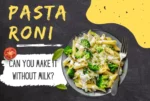While Carba-nada markets their pastas as “low net carb” and keto-friendly options, there is some skepticism from nutritionists regarding the legitimacy of their stated carb counts. Carba-nada produces three types of pastas – Protein Plus, Low Carb and Pasta Zero – that purport to have 8 grams, 4 grams and 1 gram of carbs per serving respectively.
However, these pastas rely primarily on konjac flour as an alternative to wheat, which some experts argue may not provide an accurate measure of digestible carbs due to the type of fiber in konjac. Meanwhile, alternative low carb pasta options made from vegetables, legumes or eggs instead of wheat tend to actually contain negligible digestible carbs. Though konjac flour contains nearly zero carbs itself, it has been linked to potential digestive side effects for some people.
Overall, while Carba-nada pastas likely contain fewer digestible carbs than wheat pasta, there is debate around how accurately they can be deemed truly “low carb.”
What is Carba-nada Pasta?
Carba-nada markets itself as a brand of truly low net carb and keto-friendly pastas. The company produces three main types of pasta aimed at people following low carb and ketogenic diets:
- Pasta Zero contains 1 gram of net carbs per serving and is made with pea protein and konjac flour.
- Low Carb pasta contains 4 grams of net carbs per serving through a blend of konjac and chickpea flours.
- Protein Plus pasta contains 8 grams of net carbs per serving and is made with wheat gluten and konjac flour.
All Carba-nada pastas rely primarily on konjac flour as an alternative to traditional wheat semolina flour in order to achieve their marketed low carb claims. However, some experts question whether their stated carb counts accurately reflect digestible carbohydrates.
Ingredients in Carba-nada Pasta
Carba-nada pasta uses alternative ingredients and flours in place of traditional wheat semolina flour in order to achieve their low carb claims.
Their Protein Plus pasta contains wheat gluten as the primary ingredient to provide protein, along with konjac flour which is made from the konjac yam plant.
The Low Carb option lists konjac flour as the first ingredient followed by chickpea flour, forgoing wheat completely. Chickpeas naturally contain fewer digestible carbs than wheat.
Finally, Pasta Zero contains pea protein alongside konjac flour as its primary ingredients, omitting any grains from the blend. Pea protein paired with konjac flour aims to minimize net carb content per serving.
All Carba-nada pastas are therefore made without standard wheat semolina flour, which contains around 28 grams of net carbs per 85 gram serving – the standard serving size listed for Carba-nada pasta.
Instead, Carba-nada relies on konjac flour and other alternative flours to produce pastas with dramatically lower stated carb counts ranging from 1 gram per serving up to 8 grams.
However, nutritionists note that while konjac flour itself contains nearly zero digestible carbohydrates, the particular type of fiber in this ingredient may not fully account for non-digestible carbs as claimed. Many consider the majority of carbs contained in konjac flour – in the form of glucomannan polysaccharides – to be indigestible and thus not reflective of a pasta’s true net carb content.
This has led some experts to question whether Carba-nada’s official carb counts for their konjac-based pastas provide an accurate depiction of how many digestible carbohydrates are truly present and available to be turned into glucose, potentially impacting blood sugar and ketosis.
Carbs in Carba-nada Pasta
While Carba-nada markets their range of pastas as containing drastically lower net carbs per serving compared to traditional wheat pasta, there is skepticism from some nutrition experts regarding the legitimacy of their official carb counts.
Carba-nada claims their Protein Plus pasta contains 8 grams of net carbs per 85 gram serving. Their Low Carb pasta is said to provide only 4 grams of net carbs per serving of the same size. Meanwhile, Pasta Zero pasta claims to contain a miniscule 1 gram of net carbs per 85 gram portion.
These counts would represent dramatic reductions compared to the roughly 28 grams of net carbs contained in an equivalent-sized portion of standard wheat pasta. However, nutritionists argue that the type of fiber present in konjac flour – the primary ingredient in all Carba-nada pastas – may not provide an accurate reflection of truly digestible carbs.
While konjac flour itself contains almost no digestible carbohydrates due to being comprised mostly of glucomannan polysaccharides, experts note that this particular type of fiber is not fullysubtracted from total carb counts when calculating net carbs. This is because many nutritionists considermost of the carbs in konjac flour to be indigestible and thus not reflective of a food’simpact on blood sugar or ketosis.
As such, some nutritionists argue that Carba-nada’s officially-listed carb counts for their konjac-based pastas cannot reliably indicate how many digestible carbs are truly present and availableto be used by the body. This could mean that the actual rise in blood sugarand impact on ketosis from eating Carba-nada pasta may be greater than what would be expected based solely on their listed 1 gram to 8 gram range of net carbs per serving.
While Carba-nada pastas likely do contain fewer digestible carbs than standard wheat pasta due to their basis in konjac flour and other alternatives, there is debate around how accurately they can effectively be categorized as truly “low carb” based on the limited subtractibility of fiber from konjac in calculating net carb counts.
Alternative Low Carb Pastas
While Carba-nada pastas aim to offer consumers low carb options through their reliance on konjac flour, nutrition experts note that other alternatives can provide truly negligible carb counts through their natural ingredient compositions.
One of the lowest carb pasta alternatives is shirataki noodles, made from the konjac yam plant like konjac flour but through a different process. Raw shirataki noodles contain insoluble fiber that passes through the digestive system nearly undigested, providing virtually zero impact on blood sugar or insulin response. Their negligible carbohydrate content makes shirataki an ideal keto-friendly option.
Vegetable-based pastas made from zucchini, spaghetti squash or carrot noodles also contain nearly zero digestible carbs due to being comprised entirely of fiber rich vegetables. The texture and flavors of vegetable noodles vary but they remain an exceptionally low carb alternative to traditional wheat pasta.
Legume-based pastas offer another low carb option though with slightly higher carbohydrate counts than vegetable noodles. Pasta made from chickpea, lentil or black bean flour generally contains around 7 to 10 grams of carbs per 85 gram serving, stemming entirely from the natural carbohydrates within the legumes. However, much of this fiber tends to remain undigested.
Even egg pasta remains a viable lower carb choice compared to wheat. Though eggs contribute protein, the pasta itself is still made from enriched flour and durum wheat semolina. However, the reduced proportion of wheat flour results in egg pastas containing roughly 15 to 20 grams of net carbs per 85 gram portion on average.
In comparison, all of these alternatives – shirataki, vegetable, legume and egg pastas – provide much lower impacts on blood sugar and more genuinely negligible carb counts per serving than Carba-nada’s konjac flour-based options. This is due to how the fibers in their natural ingredients such as yam, vegetables and legumes tend to be more fully subtracted when calculating net carbs, yielding amore accurate representation of digestible carbohydrates and their potential impact on ketosis.
The superior low carb credentials of these alternative pastas stem from the fact that they rely entirely on ingredient compositions that intrinsically contain minimal digestible carbohydrates, as opposed to Carba-nada’s approach of attempting to engineer low carb pasta through innovative ingredients like konjac flour that still retain higher amounts of fiber some experts consider indigestible.
Health Effects of Konjac Flour
While konjac flour itself contains virtually zero digestible carbohydrates due to consisting mainly of indigestible glucomannan fibers, it has been linked to potential gastrointestinal side effects for some people when consumed infrequent or high amounts.
Because glucomannan fibers in konjac flour absorb up to 100 times their weight in water, they can swell dramatically within the digestive system. This swelling can cause bloating, abdominal cramping, nausea and diarrhea for individuals with sensitivities to konjac or its fibers.
Konjac can also disrupt absorptions of certain medications by binding to drugs within the gastrointestinal tract before they can be absorbed. This includes interfering with absorptions of thyroxine used to treat hypothyroidism, as well as certain cholesterol-lowering statins like atorvastatin.
As a result, the U.S. Food and Drug Administration has classified konjac man as “generally recognized as safe” for consumption. But they recommend consuming it in moderation, ideally as part of a varied diet containing reduced amounts of other high-fiber grains and legumes as well.
Excessive or frequent konjac intake should be avoided, particularly for individuals taking certain medications or with preexisting gastro intestinal sensitivities. But for most people, konjac consumed occasionally and in balanced amounts is likely well-tolerated.
While Carba-nada pastas contain fewer digestible carbs than wheat pasta due to being based on konjac flour, nutrition experts question how accurately their official carb counts reflect truly available carbohydrates due to the indigestible fibers in konjac. Alternative low carb pastas made from vegetables, legumes and eggs likely provide a more genuine representation of minimal carb content through ingredients that intrinsically contain minimal digestible carbohydrates.
FAQs
1. Is Carba-nada pasta really low carb?
Though they likely contain fewer digestible carbs than wheat pasta, experts debate how accurately Carba-nada’s listed carb counts reflect truly available carbohydrates due to konjac flour’s composition.
2. Are there any side effects from konjac flour?
For most people, konjac flour consumed occasionally is well tolerated. But it has been linked to bloating, cramping, nausea and diarrhea for some individuals due to its high fiber content.
3. Is konjac flour safe for diabetics?
Konjac flour contains nearly no digestible carbs but experts caution that its high fiber content may reduce absorption of diabetic medications. It’s best for diabetics to consume konjac in moderation and under medical supervision.
4. Do low carb pastas spike insulin?
While alternative pastas made from vegetables, legumes and eggs tend to have negligible effects on insulin, experts believe konjac-based options like Carba-nada may still moderately raise insulin levels and blood sugar compared to wheat pasta.




